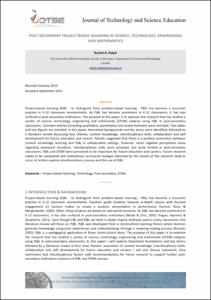Mostra el registre d'ítem simple
Post secondary project-based learning in science, technology, engineering and mathematics
| dc.contributor.author | Ralph, Rachel A. |
| dc.date.accessioned | 2016-04-13T09:11:09Z |
| dc.date.available | 2016-04-13T09:11:09Z |
| dc.date.issued | 2016-03 |
| dc.identifier.citation | Ralph, Rachel A. Post secondary project-based learning in science, technology, engineering and mathematics. "JOTSE: Journal of Technology and Science Education", Març 2016, vol. 6, núm. 1, p. 26-35. |
| dc.identifier.issn | 2013-6374 |
| dc.identifier.issn | 2014-5349 |
| dc.identifier.uri | http://hdl.handle.net/2117/85583 |
| dc.description.abstract | Project-based learning (PjBL - to distinguish from problem-based learning - PBL) has become a recurrent practice in K-12 classroom environments. As PjBL has become prominent in K-12 classrooms, it has also surfaced in post-secondary institutions. The purpose of this paper is to examine the research that has studied a variety of science, technology, engineering and mathematic subjects using PjBL in post-secondary classrooms. Eleven articles (including qualitative, quantitative and mixed methods) were included. The format includes: an introduction and background (which defines PjBL and STEM), research methods, quality appraisal used, results, and a discussion, future research and a conclusion. Two tables and two figures are included. In this paper, theoretical backgrounds and key terms were identified, followed by a literature review discussing four themes: content knowledge, interdisciplinary skills, collaboration and skill development for future education and careers. Results suggested that there is a positive connection between content knowledge learning and PjBL in collaborative settings. Additionally, some negative perceptions arose regarding teamwork situations. Interdisciplinary skills were achieved, but quite limited in post-secondary classrooms. PjBL and STEM were perceived to be important for future education and careers. Future research needs to be completed and institutional curriculum changes informed by the results of this research need to occur to further explore interdisciplinary courses and the use of PjBL |
| dc.format.extent | 10 p. |
| dc.language.iso | eng |
| dc.publisher | OmniaScience |
| dc.rights | Attribution-NonCommercial-NoDerivs 3.0 Spain |
| dc.rights.uri | http://creativecommons.org/licenses/by-nc-nd/3.0/es/ |
| dc.subject | Àrees temàtiques de la UPC::Ensenyament i aprenentatge::Ensenyament universitari |
| dc.subject | Àrees temàtiques de la UPC::Ensenyament i aprenentatge::Ensenyament secundari |
| dc.subject.lcsh | Project method in teaching |
| dc.subject.lcsh | Technology |
| dc.subject.lcsh | Postsecondary education |
| dc.subject.other | Project-based learning |
| dc.subject.other | Technology |
| dc.subject.other | STEM |
| dc.subject.other | Post-secondary education |
| dc.title | Post secondary project-based learning in science, technology, engineering and mathematics |
| dc.type | Article |
| dc.subject.lemac | Ensenyament universitari |
| dc.subject.lemac | Mètode de projectes (Ensenyament) |
| dc.subject.lemac | Educació secundària |
| dc.subject.lemac | Tecnologia |
| dc.identifier.doi | 10.3926/jotse.155 |
| dc.identifier.dl | B-2000-2012 |
| dc.rights.access | Open Access |
| local.citation.publicationName | JOTSE: Journal of Technology and Science Education |
| local.citation.volume | 6 |
| local.citation.number | 1 |
| local.citation.startingPage | 26 |
| local.citation.endingPage | 35 |


